Non-Polarizing Beamsplitter Cubes in 16 mm Cage Cubes
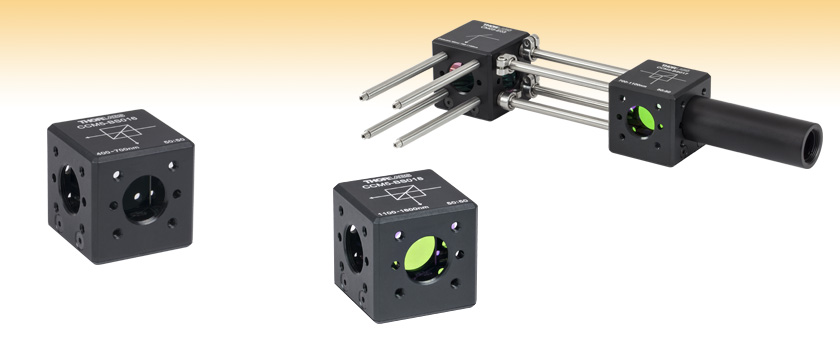
- 50:50 Split Ratio
- SM05 Lens Tube and and 16 mm Cage
System Compatible - AR Coated on All Four Optical Faces
CCM5-BS016
400 - 700 nm
CCM5-BS018
1100 - 1600 nm
CCM5-BS017 Beamsplitter Cube
Connected in a 16 mm Cage System
with a CM05-E03 Turning Mirror Cube
via Four SRSCA Adapters
Application Idea

Please Wait
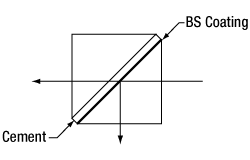
Cube Beamsplitter Diagram
(Coating and Cement Layer Not to Scale)
Features
- 16 mm Cage System and SM05 Lens Tube Compatible Mounts
- Wavelength Ranges Available
- 400 - 700 nm
- 700 - 1100 nm
- 1100 - 1600 nm
- 50:50 Split Ratio
Thorlabs’ non-polarizing beamsplitter cubes are offered mounted for compatibility with 16 mm cage systems. The dielectric beamsplitting coating is applied to the hypotenuse of one of the two prisms that make up the cube, and then cement is used to bind the two prism halves together. All of the faces of this cube have broadband antireflective coatings that minimize losses due to reflections. The housing is engraved with arrows that indicate the direction in which the beam is incident on the beamsplitter coating layer, as shown in the diagram to the right. Although light can enter through any of the other AR-coated surfaces, specifications are guaranteed when light is first incident on the side of the beamsplitter coating; see the diagram to the right.
The bottom of each cube is either 8-32 or M4 threaded. Cube housings feature four SM05-threaded entrance and exit ports for compatibility with our SM05 lens tubes. Unused ports may be blocked using SM05CP2 End Caps. Four 4-40 tapped holes surrounding each port provide compatibility with our 16 mm cage systems. The mounted beamsplitters can be connected to other cage cubes through the use of our cage rods and SRSCA adapters.
For polarization-sensitive applications, we also offer Polarizing Beamsplitting Cubes, as well as Cube-Mounted Turning Prism Mirrors for general applications and alignment. A large variety of unmounted beamsplitters are also available. For an overview of our complete selection of beamsplitting optics, please see the BS Selection Guide tab.
Please note that each beamsplitter cube is epoxied within the cage cube mount and cannot be removed.
| Item # | CCM5-BS016(/M) | CCM5-BS017(/M) | CCM5-BS018(/M) | |
|---|---|---|---|---|
| AR Coating Range | 400 - 700 nm | 700 - 1100 nm | 1100 - 1600 nm | |
| AR Coating (All Four Surfaces) |
Ravg < 0.5% at 0° AOI from 400 - 700 nm |
Ravg < 0.5% at 0° AOI from 700 - 1100 nm |
Ravg < 0.5% at 0° AOI from 1100 - 1600 nm |
|
| Split Ratio | 50:50 | |||
| Performance | Tabs= 47 ± 10%, Rabs= 47 ± 10%, Tabs + Rabs > 85%, Tavg + Ravg > 90%, |Ts - Tp| < 10%, and |Rs - Rp| < 10% |
Tabs= 47 ± 10%, Rabs= 47 ± 10%, Tabs + Rabs > 90%, |Ts - Tp| < 10%, and |Rs - Rp| < 10% |
Tabs= 47 ± 10%, Rabs= 47 ± 10%, Tabs + Rabs > 83%, Tavg + Ravg > 88%, |Ts - Tp| < 10%, and |Rs - Rp| < 10% |
|
| Ports | 4 Ports, Each with SM05 (0.535"-40) Threading and Four 4-40 Taps for Cage Rods |
|||
| Beamsplitter Material | N-BK7 | |||
| Transmitted Wavefront Errora | <λ/4 | |||
| Max Transmitted Beam Deviationb |
<5 arcmin | |||
| Reflected Beam Deviationc |
90° ± 20 arcmin | |||
| Clear Aperture | Ø12.5 mm | |||
| Surface Quality | 40-20 Scratch-Dig | |||
| Damage Threshold | Pulsed | 0.25 J/cm2 (532 nm, 10 ns, 10 Hz, Ø0.341 mm) |
0.25 J/cm2 (810 nm, 10 ns, 10 Hz, Ø0.166 mm) |
0.25 J/cm2 (1542 nm, 10 ns, 10 Hz, Ø0.282 mm) |
| CWd | 50 W/cm (532 nm, Ø1.000 mm) |
10 W/cm (1070 nm, Ø1.012 mm) |
50 W/cm (1542 nm, Ø1.030 mm) |
|
The data below is relative to the power of the incident beam. Note that some light will be absorbed by the beamsplitter coating. The blue shaded regions denote the transmission and reflection bands for which the performance is guaranteed to meet the stated specifications. The data shown here is typical and run-to-run variations will occur within the given specifications. Performance outside the shaded regions is not guaranteed.
| Coating Range | Damage Threshold | |
|---|---|---|
| 400 - 700 nm | Pulsed | 0.25 J/cm2 (532 nm, 10 ns, 10 Hz, Ø0.341 mm) |
| CWa | 50 W/cm (532 nm, Ø1.000 mm) | |
| 700 - 1100 nm | Pulsed | 0.25 J/cm2 (810 nm, 10 ns, 10 Hz, Ø0.166 mm) |
| CWa | 50 W/cm (1070 nm, Ø1.012 mm) | |
| 1100 - 1600 nm | Pulsed | 0.25 J/cm2 (1542 nm, 10 ns, 10 Hz, Ø0.282 mm) |
| CWa | 50 W/cm (1542 nm, Ø1.030 mm) | |
Damage Threshold Data for Thorlabs' Non-Polarizing Beamsplitters
The specifications to the right are measured data for Thorlabs' non-polarizing beamsplitters.
Laser Induced Damage Threshold Tutorial
The following is a general overview of how laser induced damage thresholds are measured and how the values may be utilized in determining the appropriateness of an optic for a given application. When choosing optics, it is important to understand the Laser Induced Damage Threshold (LIDT) of the optics being used. The LIDT for an optic greatly depends on the type of laser you are using. Continuous wave (CW) lasers typically cause damage from thermal effects (absorption either in the coating or in the substrate). Pulsed lasers, on the other hand, often strip electrons from the lattice structure of an optic before causing thermal damage. Note that the guideline presented here assumes room temperature operation and optics in new condition (i.e., within scratch-dig spec, surface free of contamination, etc.). Because dust or other particles on the surface of an optic can cause damage at lower thresholds, we recommend keeping surfaces clean and free of debris. For more information on cleaning optics, please see our Optics Cleaning tutorial.
Testing Method
Thorlabs' LIDT testing is done in compliance with ISO/DIS 11254 and ISO 21254 specifications.
First, a low-power/energy beam is directed to the optic under test. The optic is exposed in 10 locations to this laser beam for 30 seconds (CW) or for a number of pulses (pulse repetition frequency specified). After exposure, the optic is examined by a microscope (~100X magnification) for any visible damage. The number of locations that are damaged at a particular power/energy level is recorded. Next, the power/energy is either increased or decreased and the optic is exposed at 10 new locations. This process is repeated until damage is observed. The damage threshold is then assigned to be the highest power/energy that the optic can withstand without causing damage. A histogram such as that below represents the testing of one BB1-E02 mirror.

The photograph above is a protected aluminum-coated mirror after LIDT testing. In this particular test, it handled 0.43 J/cm2 (1064 nm, 10 ns pulse, 10 Hz, Ø1.000 mm) before damage.

| Example Test Data | |||
|---|---|---|---|
| Fluence | # of Tested Locations | Locations with Damage | Locations Without Damage |
| 1.50 J/cm2 | 10 | 0 | 10 |
| 1.75 J/cm2 | 10 | 0 | 10 |
| 2.00 J/cm2 | 10 | 0 | 10 |
| 2.25 J/cm2 | 10 | 1 | 9 |
| 3.00 J/cm2 | 10 | 1 | 9 |
| 5.00 J/cm2 | 10 | 9 | 1 |
According to the test, the damage threshold of the mirror was 2.00 J/cm2 (532 nm, 10 ns pulse, 10 Hz, Ø0.803 mm). Please keep in mind that these tests are performed on clean optics, as dirt and contamination can significantly lower the damage threshold of a component. While the test results are only representative of one coating run, Thorlabs specifies damage threshold values that account for coating variances.
Continuous Wave and Long-Pulse Lasers
When an optic is damaged by a continuous wave (CW) laser, it is usually due to the melting of the surface as a result of absorbing the laser's energy or damage to the optical coating (antireflection) [1]. Pulsed lasers with pulse lengths longer than 1 µs can be treated as CW lasers for LIDT discussions.
When pulse lengths are between 1 ns and 1 µs, laser-induced damage can occur either because of absorption or a dielectric breakdown (therefore, a user must check both CW and pulsed LIDT). Absorption is either due to an intrinsic property of the optic or due to surface irregularities; thus LIDT values are only valid for optics meeting or exceeding the surface quality specifications given by a manufacturer. While many optics can handle high power CW lasers, cemented (e.g., achromatic doublets) or highly absorptive (e.g., ND filters) optics tend to have lower CW damage thresholds. These lower thresholds are due to absorption or scattering in the cement or metal coating.

LIDT in linear power density vs. pulse length and spot size. For long pulses to CW, linear power density becomes a constant with spot size. This graph was obtained from [1].

Pulsed lasers with high pulse repetition frequencies (PRF) may behave similarly to CW beams. Unfortunately, this is highly dependent on factors such as absorption and thermal diffusivity, so there is no reliable method for determining when a high PRF laser will damage an optic due to thermal effects. For beams with a high PRF both the average and peak powers must be compared to the equivalent CW power. Additionally, for highly transparent materials, there is little to no drop in the LIDT with increasing PRF.
In order to use the specified CW damage threshold of an optic, it is necessary to know the following:
- Wavelength of your laser
- Beam diameter of your beam (1/e2)
- Approximate intensity profile of your beam (e.g., Gaussian)
- Linear power density of your beam (total power divided by 1/e2 beam diameter)
Thorlabs expresses LIDT for CW lasers as a linear power density measured in W/cm. In this regime, the LIDT given as a linear power density can be applied to any beam diameter; one does not need to compute an adjusted LIDT to adjust for changes in spot size, as demonstrated by the graph to the right. Average linear power density can be calculated using the equation below.

The calculation above assumes a uniform beam intensity profile. You must now consider hotspots in the beam or other non-uniform intensity profiles and roughly calculate a maximum power density. For reference, a Gaussian beam typically has a maximum power density that is twice that of the uniform beam (see lower right).
Now compare the maximum power density to that which is specified as the LIDT for the optic. If the optic was tested at a wavelength other than your operating wavelength, the damage threshold must be scaled appropriately. A good rule of thumb is that the damage threshold has a linear relationship with wavelength such that as you move to shorter wavelengths, the damage threshold decreases (i.e., a LIDT of 10 W/cm at 1310 nm scales to 5 W/cm at 655 nm):

While this rule of thumb provides a general trend, it is not a quantitative analysis of LIDT vs wavelength. In CW applications, for instance, damage scales more strongly with absorption in the coating and substrate, which does not necessarily scale well with wavelength. While the above procedure provides a good rule of thumb for LIDT values, please contact Tech Support if your wavelength is different from the specified LIDT wavelength. If your power density is less than the adjusted LIDT of the optic, then the optic should work for your application.
Please note that we have a buffer built in between the specified damage thresholds online and the tests which we have done, which accommodates variation between batches. Upon request, we can provide individual test information and a testing certificate. The damage analysis will be carried out on a similar optic (customer's optic will not be damaged). Testing may result in additional costs or lead times. Contact Tech Support for more information.
Pulsed Lasers
As previously stated, pulsed lasers typically induce a different type of damage to the optic than CW lasers. Pulsed lasers often do not heat the optic enough to damage it; instead, pulsed lasers produce strong electric fields capable of inducing dielectric breakdown in the material. Unfortunately, it can be very difficult to compare the LIDT specification of an optic to your laser. There are multiple regimes in which a pulsed laser can damage an optic and this is based on the laser's pulse length. The highlighted columns in the table below outline the relevant pulse lengths for our specified LIDT values.
Pulses shorter than 10-9 s cannot be compared to our specified LIDT values with much reliability. In this ultra-short-pulse regime various mechanics, such as multiphoton-avalanche ionization, take over as the predominate damage mechanism [2]. In contrast, pulses between 10-7 s and 10-4 s may cause damage to an optic either because of dielectric breakdown or thermal effects. This means that both CW and pulsed damage thresholds must be compared to the laser beam to determine whether the optic is suitable for your application.
| Pulse Duration | t < 10-9 s | 10-9 < t < 10-7 s | 10-7 < t < 10-4 s | t > 10-4 s |
|---|---|---|---|---|
| Damage Mechanism | Avalanche Ionization | Dielectric Breakdown | Dielectric Breakdown or Thermal | Thermal |
| Relevant Damage Specification | No Comparison (See Above) | Pulsed | Pulsed and CW | CW |
When comparing an LIDT specified for a pulsed laser to your laser, it is essential to know the following:

LIDT in energy density vs. pulse length and spot size. For short pulses, energy density becomes a constant with spot size. This graph was obtained from [1].
- Wavelength of your laser
- Energy density of your beam (total energy divided by 1/e2 area)
- Pulse length of your laser
- Pulse repetition frequency (prf) of your laser
- Beam diameter of your laser (1/e2 )
- Approximate intensity profile of your beam (e.g., Gaussian)
The energy density of your beam should be calculated in terms of J/cm2. The graph to the right shows why expressing the LIDT as an energy density provides the best metric for short pulse sources. In this regime, the LIDT given as an energy density can be applied to any beam diameter; one does not need to compute an adjusted LIDT to adjust for changes in spot size. This calculation assumes a uniform beam intensity profile. You must now adjust this energy density to account for hotspots or other nonuniform intensity profiles and roughly calculate a maximum energy density. For reference a Gaussian beam typically has a maximum energy density that is twice that of the 1/e2 beam.
Now compare the maximum energy density to that which is specified as the LIDT for the optic. If the optic was tested at a wavelength other than your operating wavelength, the damage threshold must be scaled appropriately [3]. A good rule of thumb is that the damage threshold has an inverse square root relationship with wavelength such that as you move to shorter wavelengths, the damage threshold decreases (i.e., a LIDT of 1 J/cm2 at 1064 nm scales to 0.7 J/cm2 at 532 nm):

You now have a wavelength-adjusted energy density, which you will use in the following step.
Beam diameter is also important to know when comparing damage thresholds. While the LIDT, when expressed in units of J/cm², scales independently of spot size; large beam sizes are more likely to illuminate a larger number of defects which can lead to greater variances in the LIDT [4]. For data presented here, a <1 mm beam size was used to measure the LIDT. For beams sizes greater than 5 mm, the LIDT (J/cm2) will not scale independently of beam diameter due to the larger size beam exposing more defects.
The pulse length must now be compensated for. The longer the pulse duration, the more energy the optic can handle. For pulse widths between 1 - 100 ns, an approximation is as follows:

Use this formula to calculate the Adjusted LIDT for an optic based on your pulse length. If your maximum energy density is less than this adjusted LIDT maximum energy density, then the optic should be suitable for your application. Keep in mind that this calculation is only used for pulses between 10-9 s and 10-7 s. For pulses between 10-7 s and 10-4 s, the CW LIDT must also be checked before deeming the optic appropriate for your application.
Please note that we have a buffer built in between the specified damage thresholds online and the tests which we have done, which accommodates variation between batches. Upon request, we can provide individual test information and a testing certificate. Contact Tech Support for more information.
[1] R. M. Wood, Optics and Laser Tech. 29, 517 (1998).
[2] Roger M. Wood, Laser-Induced Damage of Optical Materials (Institute of Physics Publishing, Philadelphia, PA, 2003).
[3] C. W. Carr et al., Phys. Rev. Lett. 91, 127402 (2003).
[4] N. Bloembergen, Appl. Opt. 12, 661 (1973).
In order to illustrate the process of determining whether a given laser system will damage an optic, a number of example calculations of laser induced damage threshold are given below. For assistance with performing similar calculations, we provide a spreadsheet calculator that can be downloaded by clicking the button to the right. To use the calculator, enter the specified LIDT value of the optic under consideration and the relevant parameters of your laser system in the green boxes. The spreadsheet will then calculate a linear power density for CW and pulsed systems, as well as an energy density value for pulsed systems. These values are used to calculate adjusted, scaled LIDT values for the optics based on accepted scaling laws. This calculator assumes a Gaussian beam profile, so a correction factor must be introduced for other beam shapes (uniform, etc.). The LIDT scaling laws are determined from empirical relationships; their accuracy is not guaranteed. Remember that absorption by optics or coatings can significantly reduce LIDT in some spectral regions. These LIDT values are not valid for ultrashort pulses less than one nanosecond in duration.

A Gaussian beam profile has about twice the maximum intensity of a uniform beam profile.
CW Laser Example
Suppose that a CW laser system at 1319 nm produces a 0.5 W Gaussian beam that has a 1/e2 diameter of 10 mm. A naive calculation of the average linear power density of this beam would yield a value of 0.5 W/cm, given by the total power divided by the beam diameter:

However, the maximum power density of a Gaussian beam is about twice the maximum power density of a uniform beam, as shown in the graph to the right. Therefore, a more accurate determination of the maximum linear power density of the system is 1 W/cm.
An AC127-030-C achromatic doublet lens has a specified CW LIDT of 350 W/cm, as tested at 1550 nm. CW damage threshold values typically scale directly with the wavelength of the laser source, so this yields an adjusted LIDT value:

The adjusted LIDT value of 350 W/cm x (1319 nm / 1550 nm) = 298 W/cm is significantly higher than the calculated maximum linear power density of the laser system, so it would be safe to use this doublet lens for this application.
Pulsed Nanosecond Laser Example: Scaling for Different Pulse Durations
Suppose that a pulsed Nd:YAG laser system is frequency tripled to produce a 10 Hz output, consisting of 2 ns output pulses at 355 nm, each with 1 J of energy, in a Gaussian beam with a 1.9 cm beam diameter (1/e2). The average energy density of each pulse is found by dividing the pulse energy by the beam area:

As described above, the maximum energy density of a Gaussian beam is about twice the average energy density. So, the maximum energy density of this beam is ~0.7 J/cm2.
The energy density of the beam can be compared to the LIDT values of 1 J/cm2 and 3.5 J/cm2 for a BB1-E01 broadband dielectric mirror and an NB1-K08 Nd:YAG laser line mirror, respectively. Both of these LIDT values, while measured at 355 nm, were determined with a 10 ns pulsed laser at 10 Hz. Therefore, an adjustment must be applied for the shorter pulse duration of the system under consideration. As described on the previous tab, LIDT values in the nanosecond pulse regime scale with the square root of the laser pulse duration:

This adjustment factor results in LIDT values of 0.45 J/cm2 for the BB1-E01 broadband mirror and 1.6 J/cm2 for the Nd:YAG laser line mirror, which are to be compared with the 0.7 J/cm2 maximum energy density of the beam. While the broadband mirror would likely be damaged by the laser, the more specialized laser line mirror is appropriate for use with this system.
Pulsed Nanosecond Laser Example: Scaling for Different Wavelengths
Suppose that a pulsed laser system emits 10 ns pulses at 2.5 Hz, each with 100 mJ of energy at 1064 nm in a 16 mm diameter beam (1/e2) that must be attenuated with a neutral density filter. For a Gaussian output, these specifications result in a maximum energy density of 0.1 J/cm2. The damage threshold of an NDUV10A Ø25 mm, OD 1.0, reflective neutral density filter is 0.05 J/cm2 for 10 ns pulses at 355 nm, while the damage threshold of the similar NE10A absorptive filter is 10 J/cm2 for 10 ns pulses at 532 nm. As described on the previous tab, the LIDT value of an optic scales with the square root of the wavelength in the nanosecond pulse regime:

This scaling gives adjusted LIDT values of 0.08 J/cm2 for the reflective filter and 14 J/cm2 for the absorptive filter. In this case, the absorptive filter is the best choice in order to avoid optical damage.
Pulsed Microsecond Laser Example
Consider a laser system that produces 1 µs pulses, each containing 150 µJ of energy at a repetition rate of 50 kHz, resulting in a relatively high duty cycle of 5%. This system falls somewhere between the regimes of CW and pulsed laser induced damage, and could potentially damage an optic by mechanisms associated with either regime. As a result, both CW and pulsed LIDT values must be compared to the properties of the laser system to ensure safe operation.
If this relatively long-pulse laser emits a Gaussian 12.7 mm diameter beam (1/e2) at 980 nm, then the resulting output has a linear power density of 5.9 W/cm and an energy density of 1.2 x 10-4 J/cm2 per pulse. This can be compared to the LIDT values for a WPQ10E-980 polymer zero-order quarter-wave plate, which are 5 W/cm for CW radiation at 810 nm and 5 J/cm2 for a 10 ns pulse at 810 nm. As before, the CW LIDT of the optic scales linearly with the laser wavelength, resulting in an adjusted CW value of 6 W/cm at 980 nm. On the other hand, the pulsed LIDT scales with the square root of the laser wavelength and the square root of the pulse duration, resulting in an adjusted value of 55 J/cm2 for a 1 µs pulse at 980 nm. The pulsed LIDT of the optic is significantly greater than the energy density of the laser pulse, so individual pulses will not damage the wave plate. However, the large average linear power density of the laser system may cause thermal damage to the optic, much like a high-power CW beam.
| Posted Comments: | |
user
(posted 2023-01-09 12:43:12.76) Do you offer any empty 16 mm cage or SM05 compatible beamsplitter cubes? cdolbashian
(posted 2023-01-23 12:15:43.0) Thank you for contacting Thorlabs. We do offer empty 16 mm cage cubes, which can be found here: https://www.thorlabs.com/newgrouppage9.cfm?objectgroup_id=3045. user
(posted 2021-11-22 02:22:23.117) Hi,
Whether these mounted beam-splitters can be securely fastened with Kinematic platform mounts like KM100PM or KM100B,.? In other words, whether the suggested cage system is a must for their usage..? YLohia
(posted 2021-11-23 03:28:19.0) Hello, thank you for contacting Thorlabs. The suggested cage system is not the only possible installation method. The KM100PM is used to install the optics with a maximum size of 25.4 mm, but the package size of the mounted beamsplitter cubes is 30 mm, which is not compatible with the KM100PM.
For such applications, we also offer unmounted beamsplitters that can be found here: https://www.thorlabs.com/newgrouppage9.cfm?objectgroup_id=754. For an overview of the mounting solutions for our beamsplitter cubes, please refer to the "BS Cube Mounting" tab on that page. user
(posted 2021-09-14 09:34:41.483) These 16 mm beamsplitters appear to have a pair of alignment holes on each face in addition to the four threaded holes. I was not able to locate any specifications or tolerances for these holes on any of the 16 mm cage systems. Can you please provide the dimensions and/or tolerances for these features? YLohia
(posted 2021-09-17 03:49:50.0) Thank you for contacting Thorlabs. The dimensions of these holes are: 0.094 inch diameter, tolerance: ±0.005 inch. mike.ortiz
(posted 2016-09-23 15:08:05.577) It would be nice to have some light blocking panels to screw on the unused sides of the cube. This also goes for your larger cubes. jlow
(posted 2016-09-23 03:51:38.0) Response from Jeremy at Thorlabs: The ports on these mounted beamsplitters cubes are SM05 threaded so you can use the SM05CP2 threaded end caps to block the unused sides. drobniak
(posted 2016-09-08 06:03:11.283) Hello again and thank you for your previous answer!
I am still using my CCM5-BS018/M and I do not measure the same intensity on both outputs. As I understood, it is supposed to split the incident light in "approximately" 50%/50% on both outputs.
I have tried with several light emitters: An unpolarised emitter around 1500nm, an unpolarised cold light source (white visible colour) and also a red laser pointer (the latter is partially linear polarised).
Any idea why the light measured does not have the same intensity on both outputs of the CCM5-BS018/M?
Small additional precision: the intensity is measured on the both outputs with the same photodiode, centered with the same adaptor.
Thanks
Pierre Drobniak tfrisch
(posted 2016-09-08 10:24:37.0) Hello, thank you for contacting us again. I will contact you directly about the split ratio tolerance and some alternatives that may be more suitable for your application. drobniak
(posted 2016-09-05 14:37:55.977) To whom it may concern,
I recently bought the CCM5-BS018/M for my master's thesis, and I cannot find the dimensions of the thread on internet...
It might be a stupid question, but could you please indicate me what is the pitch, the diameter and the angle of the SM05 thread on the CCM5-BS018/M? And also for the SM1 thread on the CCM1-BS015/M?
Thanks in advance for your time.
Sincerly yours,
Pierre Drobniak tfrisch
(posted 2016-09-06 08:09:25.0) Hello, thank you for contacting Thorlabs. SM1 and SM05 are respectively 1.035"-40tpi and 0.535"-40tpi. I will contact you with full thread specs. |
Beamsplitter Selection Guide
Thorlabs' portfolio contains many different kinds of beamsplitters, which can split beams by intensity or by polarization. We offer plate and cube beamsplitters, though other form factors exist, including pellicle and birefringent crystal. For an overview of the different types and a comparison of their features and applications, please see our overview. Many of our beamsplitters come in premounted or unmounted variants. Below is a complete listing of our beamsplitter offerings. To explore the available types, wavelength ranges, splitting/extinction ratios, transmission, and available sizes for each beamsplitter category, click More [+] in the appropriate row below.Plate Beamsplitters
| Non-Polarizing Plate Beamsplitters |
|---|
| Polarizing Plate Beamsplitters |
|---|
Cube Beamsplitters
| Non-Polarizing Cube Beamsplitters |
|---|
| Polarizing Cube and Polyhedron Beamsplitters |
|---|
Pellicle Beamsplitters
| Non-Polarizing Pellicle Beamsplitters |
|---|
Crystal Beamsplitters
| Polarizing Crystal Beamsplitters |
|---|
Other
| Other Beamsplitters |
|---|
 Products Home
Products Home









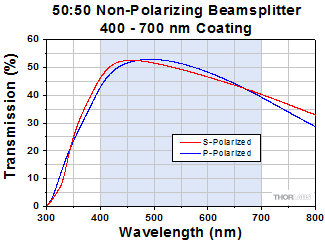
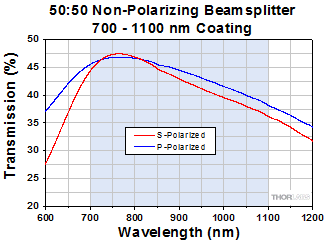
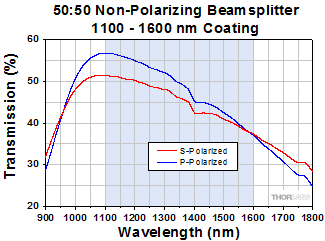



 16 mm Cage, Mounted Beamsplitter Cubes
16 mm Cage, Mounted Beamsplitter Cubes